![]()
![]()
![]()
Use LEFT and RIGHT arrow keys to navigate between flashcards;
Use UP and DOWN arrow keys to flip the card;
H to show hint;
A reads text to speech;
44 Cards in this Set
- Front
- Back
|
Body- building plan |
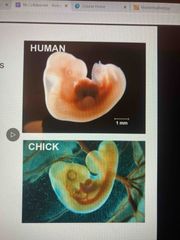
Human embryo at 5 weeks shows features Common features of embryonic stages among animals Experiments have identified patterns of gene expression that direct cells in development |
|
|
Model organisms |
Organisms chosen for study due to the ease with which they can be studied in a lab Development occurs at many points in animal life cycle |
|
|
Across a range of animals, embryonic development... |

Has common stages |
|
|
Four basic processes mold embryos during development |
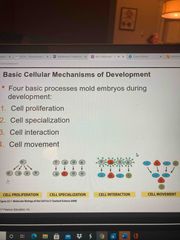
1. Cell proliferation 2. Cell specialization 3. Cell interaction 4. Cell movement |
|
|
Fertilization |
Formation of a diploid zygote from a haploid egg and a haploid sperm |
|
|
Molecules and events at egg surface play role in fertilization |
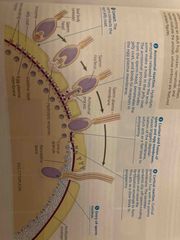
Sperm penetrate protective layer Receptors on egg surface bind to molecules on sperm surface Changes at egg surface prevent polyspermy |
|
|
Polyspermy |
Entry of multiple sperm nuclei into the egg |
|
|
Acrosomal reaction |
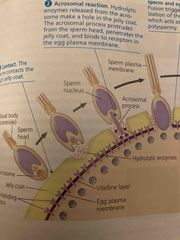
Triggered when sperm meets egg Tip of sperm, acrosome cap releases hydrolytic enzyme that digest material surrounding egg |
|
|
Fast block to polyspermy |
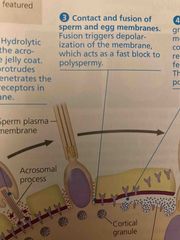
Gamete contact and fusion depolarizes (changes charge distribution) the egg cell membrane Does not happen in mammals Eggs typically have one charge inside and another outside. |
|
|
Cortical reaction starts.. |
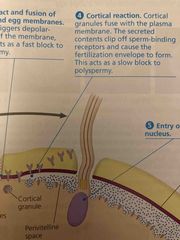
Fusion of egg and Soren initiates cortical reaction After sperm binds, vesicles just beneath the egg plasma membrane release contents and form a fertilization envelope (slow block to polyspermy) |
|
|
How does the cortical reaction work? |
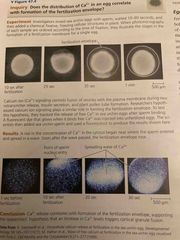
Requires a high concentration of Ca ions in the egg The reaction is triggered by a change in Ca concentration Ca spreads across the egg correlates with the appearance of the fertilization envelope |
|
|
Egg activation |
Rise in Ca in the cytosol increase rates of cellular respiration and protein synthesis by the egg cell ( if you injected Ca in egg, you could start this) With these rapid changes in metabolism, the egg is activated Proteins and mRNAs needed for activation are already present in the egg Sperm nucleus fuses with egg nucleus and cell division begins |
|
|
Zona pellucida |

Extracellular matrix of egg surrounded by Layer of follicle cells (sperm must travel through it to get to zone) Sperm then triggers cortical reaction In mammals first cell division is 12-36 hours after a perm binding |
|
|
Cleavage |
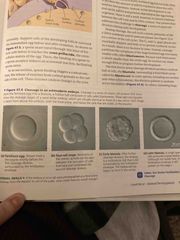
Period of rapid cell division without growth Partitions the cytoplasm of one large cell into smaller cells (blast omeres) |
|
|
Blastula |
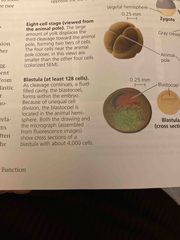
A ball of cells with fluid-filled cavity called blastociel |
|
|
Cleavage in Frogs and other land animals |
Cleavage is asymmetric due to distribution of yolk (stored nutrients) Vegetal pole has more yolk and animal pole has less yolk |
|
|
Stages of cleavage in frogs |
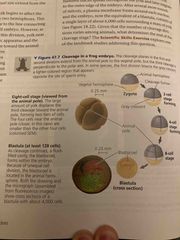
First two cleavage furrows form 4 equally sized blastomeres Third cleavage is asymmetric, forming unequally sized blastomeres This asymmetry is due to the yolk in the vegetal hemisphere |
|
|
Holoblastic cleavage |
Complete division of egg In species that have little or moderate amount of yolk (sea urchins, frogs, mammals) |
|
|
Meroblastic cleavge |
Incomplete division of egg In species with heavy yolk egg ( reptiles and birds) |
|
|
Cleavge in drosophila and other insects |
Multiple rounds of mitosis occur without cytokinesis |
|
|
Regulation of cleavage |
I total development is carried out by RNA and proteins deposited in the egg during oogenesis After cleavage the egg cytoplasm has been divided among many blastomeres, each of which can make sufficient RNA to program the cells metabolism and development ie: stops when ratio of nucleo to cytoplasm volume is met and enough DNA to support cell |
|
|
Morphogenisis |
Process by which cells occupy their appropriate locations (involves grastulation and organogenesis) |
|
|
Gastrulation |
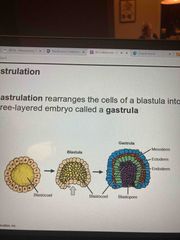
Movement of cells from blastula surface to the interior of the embryo Forms 3 layered embryo called a gastrula |
|
|
Organogenesis |
Formation of organs |
|
|
Germ layers |
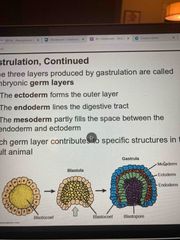
3 layers formed during gastrulation (first step to commit to cell path) Each layer contributes to specific structures in adult animal Ectoderm: outer layer Endoderm: lines digestive tract Mesoderm: partly fills space btw ecto and endoderm |
|
|
Ectoderm (outer layer) |
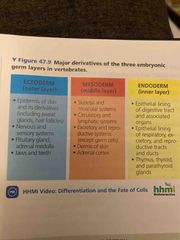
Epidermis of skin and it’s derivatives (sweat glands and hair follicles) Nervous and sensory system Pituitary gland, adrenal medulla(outside adrenal gland) Jaws and teeth |
|
|
Mesoderm (middle layer) |
Skeletal and muscle systems Circulatory and lymphatic systems Dermis of skin Adrenal cortex (internal adrenal gland) |
|
|
Endoderm (inner layer) |
Epithelial lining of digestive tract and associated organs Epithelial lining of respiratory, excretory, and reproductive tracts and ducts Thymus, thyroid, parathyroid glands |
|
|
Visualization of gastrulation |
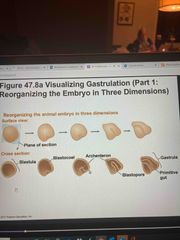
Duetorostomes (anus first, mouth second, blastopore) |
|
|
Gastrulation primary cell layers visual |

Back (Definition) |
|
|
Gastrulation in frog |
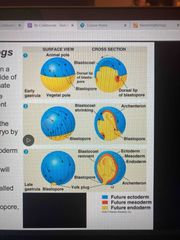
Frog is oriented based on where sperm enters Begins when group of cells on dorsal side of blastula (Forms a crease along region where gray crescent formed) Involution: cells move from embryo surface into embryo (Become endo and mesoderm) Cells on surface become ectoderm New cavity formed is archenteron (opens through blastopore to become anus |
|
|
Gastrulation in chicks |
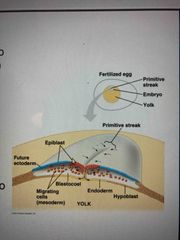
Before gastrulation, composed of epiblast (upper) and hypoblast (lower) Epiblast cells move towards the midline of the blastoderm and then into the embryo toward the yolk Midline thickens (primitive streak) Hypoblast cells contribute to sac that surrounds yolk and a connection btw yolk n embryo |
|
|
Gastrulation in Humans |
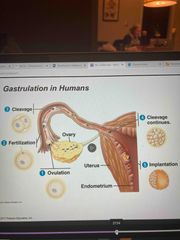
Back (Definition) |
|
|
Gastrulation in humans |

Human eggs have little yolk so won’t survive on own Inner cell mass: cluster of cells at one end of the blastocyst Trophoblast: outer layer of embryo and does not contribute to embryo but instead initiated implantation (releases enzymes that digest mother) |
|
|
After implantation |

Trophoblast continue nto expand and embryonic membranes are formed These enclose special structures outside of embryo |
|
|
Similar to chick embryo... |
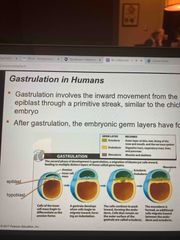
Primitive streak is formed Gastrulation happens as implantation is happening After gastrulation, embryonic germ layers have formed |
|
|
4 stages of embryonic development |
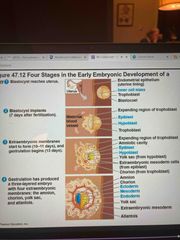
A |
|
|
Stage one |
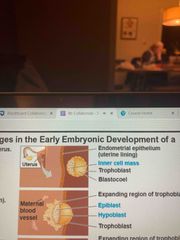
Blastocyst reached uterus |
|
|
Stage 2 |
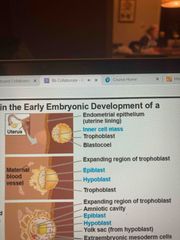
Blastocyst implants ( 7 days after fertilization) |
|
|
Stage 3 |
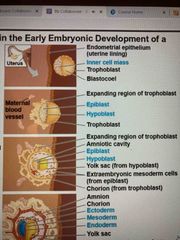
Extra embryonic membranes start to form 10-11 days Gastrulation begin (13 days) |
|
|
Stage 4 |
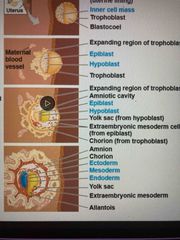
Gastrulation makes 3 layer embryo 4 extraembryonic membranes (amnion, chorion, yolk sac, and Allantois) |
|
|
Adaptations of amniotes |
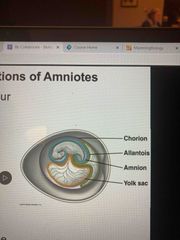
Land vertebrates form 4 extra embryonic membranes Provide life support for further development |
|
|
4 membranes |
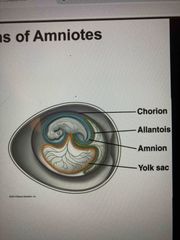
Chorion: functions in gas exchange Amnion: encloses amniotic fluid Yolk sac: encloses yolk Allantois: disposed of waste products and contributes to gas exchange |
|
|
A |
A |

